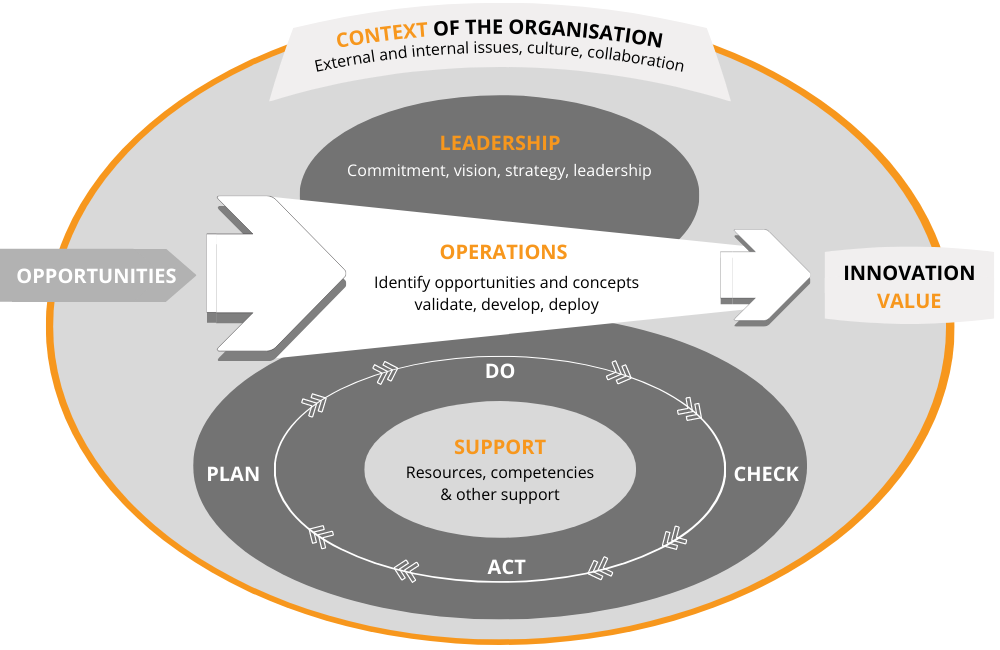
The elements of an Innovation Management System, according to the ISO Innovation Management Standards
Posted 3 years ago
Could you accurately name all the elements that exist within an Innovation Management System? Fortunately, the ISO Innovation Management Standards provide a clear, concise explanation of the five key elements required for a functioning Innovation Management System, that can be used as a guide when creating a new innovation system from scratch, or improving an existing innovation system for optimal performance.
Innovation management can be defined as the process of establishing an innovation vision, strategy, policy and objectives, and developing the organisational structures and processes required to achieve those objectives through planning, support, operations, performance, evaluation, and improvement (ISO 56000:2020 – Innovation Management Fundamentals and Vocabulary).
Put more simply, it is the process of managing new ideas from ideation to value. This process, combined with the key stakeholders that influence the outcomes and the cultural forces that come into play as the process rolls out, make up an organisation’s innovation management system.
Elements of an Innovation Management System
According to the Global ISO Innovation Management Standards, a productive innovation management system has five key elements. Each element addresses a particular aspect in the process of realising value from innovation, and together creates a comprehensive systematic overview (a ‘helicopter view’) of your organisation’s innovation activities.
The five key elements include:
-
- Context of the Organisation. These are the external and internal issues that affect the organisation, the organisational culture and its ability to collaborate – including collaboration with external stakeholders and collaboration between multiple departments within the organisation. This element also includes the innovation competencies of the people within the organisation.
- Leadership. The leadership and commitment demonstrated by management to the innovation agenda, ensuring the innovation vision and strategy are established and well-communicated, and a culture of innovation is led from the top. This element greatly influences whether the innovation system becomes successfully integrated into the existing core structures of the organisation or just languishes on the periphery.
- Operations. This is the planning, control, and implentation of innovation initiatives.
- Support. This is the resources needed to establish and maintain the innovation system. Without sufficient resources dedicated to the innovation system, outcomes will not be achieved.
- Innovation Value. The intended outcomes of the innovation system will vary depending on the organisational objectives, and value created from innovation may take several forms. Innovation objectives must be established early on, clearly communicated to all stakeholders, and be measurable or verifiable.
These elements are underpinned by a continual Plan-Do-Check-Act (PDCA) cycle, enabling constant improvement of the system and ensuring outcomes are being achieved.

The elements of an Innovation Management System according to the ISO innovation management standards
To understand how these elements interact, three key dividers can be used, ‘Drivers’, ‘Enablers’, and ‘Results’.
Drivers: Drivers (Context of the organisation and Leadership) are factors that set the strategic direction of the IMS and consider the internal and external operating environment of the organisation so that the system stays relevant and delivers continuous value.
Enablers: Enablers (Operations and Support) are the processes, tools and approaches that support an organisation’s pursuit of its innovation goals and objectives.
Results: Results (Innovation Value) are the organisation’s measures of success and the process of realising value from innovation.
When all elements are working together effectively, an innovation system is optimised to deliver the desired results with minimal risk and efficient use of resources.
For support aligning your innovation system to the Global ISO Innovation Management Standards, and to gain confidence that your innovation system is optimised to maximise productivity, reduce risk, and eliminate wasted resources, try our Innovation Navigator™ tool.